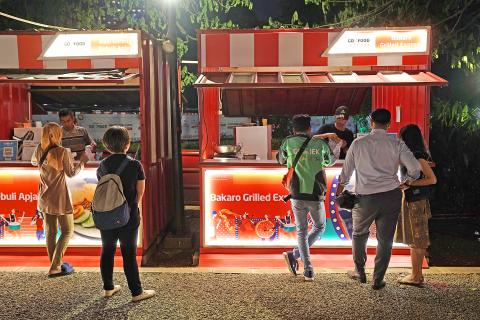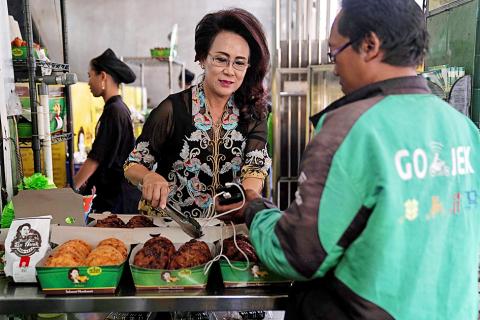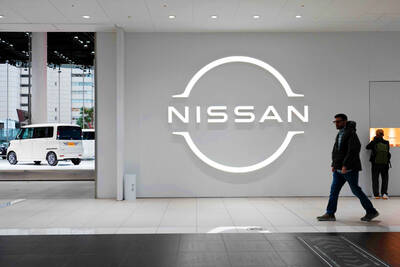Nanik Soelistiowati, the owner of a banana fritter stall in West Jakarta, is the unlikely prize in a battle between two of the most valuable technology start-ups in Asia.
The 64-year-old woman signed up for Gojek’s nascent food delivery service in 2015 after hearing about it from her children. Delivery motorbikes slalomed through traffic jams to deliver her delicious snack, which uses honey for a caramelized flavor, to all parts of congestion-choked Jakarta. Sales took off.
Then in 2017, rival Grab Holdings Inc approached her with an offer to undercut Gojek’s take of 15 percent. It was too good to refuse, and when Grab pushed aggressive discounts to consumers, demand spiked so much that Soelistiowati ran out of bananas to fry.

Photo: Bloomberg
SOUTHEAST ASIA’S HOTTEST
Grab and Gojek became Southeast Asia’s two hottest start-ups largely on the strength of their ride-hailing businesses, but now they are in the midst of an international food fight.
In the space of just four years, Jakarta-based Gojek has grown to have 400,000 food merchants such as Soelistiowati cooking up 50 million orders a month, or about 1.7 million orders per day, across locations in Indonesia, Vietnam and Thailand.

Photo: Bloomberg
Singapore’s Grab came in later, but it is catching up fast with the help of massive funding from SoftBank Group Corp and the acquisition of Uber Technologies Inc’s local ride-hailing and food delivery business last year.
This year, Grab says it has tripled sales and doubled its roster of merchants.
COMMON GROUND
The two companies are led by a pair who met while studying at Harvard Business School, with Gojek cofounder and chief executive officer Nadiem Makarim and Grab cofounder and chief executive officer Anthony Tan finding common ground in their shared background.
They also concur in seeing a bright spot in the food delivery market because it offers much more attractive margins than the more established ride-hailing business, said Florian Hoppe, a Singapore-based partner at Bain & Co.
“Today, the food delivery market is significantly smaller than transport in Southeast Asia, but it’s expected to be on par or bigger than on-demand transport by revenue over the next five years,” Hoppe said.
Globally, the online food order industry has grown into a hyper-competitive field, which has led to consolidation as companies claw for a bigger slice of more than US$300 billion in restaurant deliveries.
However, in Indonesia online food deliveries account for just 1.3 percent of the total food market, compared with 8 percent in the US and about 12 percent in China, according to data from Euromonitor.
“We are only scratching the surface in terms of penetration in this part of the world,” Gojek chief food officer Catherine Sutjahyo said. “We truly believe that this is a big opportunity.”
Elsewhere in the world, companies such as Uber are also aggressively moving into the food delivery business in search for higher profit margins, having identified the same opening as Grab and Gojek.
The Southeast Asian duo offer digital payments and sundry other services on top of their ride and food delivery staples, aiming to be the WeChat-like super app in the region.
Gojek, which processed US$2 billion of food delivery transactions last year, is not content just riding a rising tide. The company employs data and machine learning to study patterns of consumption, driver behavior and traffic.
So, when a user opens its app, the company takes into account their location, the time of day and their past behavior to predict their most likely desire. The GoFood app offers personalized recommendations based on what the user typically orders and food they have already rated.
Since Gojek embarked on international expansion late last year, GoFood has become available in Hanoi, Ho Chi Minh City and Bangkok, intensifying competition with Grab.
FOOD STALL FESTIVALS
Another successful Gojek strategy has been to organize food stall feasts at the Gelora Bung Karno Stadium in central Jakarta — where Guns N’ Roses and Linkin Park have staged performances.
One Friday evening in July, about 50 stalls outside the sprawling stadium offer crispy chicken topped with crushed chili paste, spice-filled beef soup and shaved ice in sweet coconut milk. People can eat in beanbag chairs or at tables nearby.
This carnival-like open-air space is called the GoFood Festival, and it has been so popular that Gojek has set up 30 such venues across the Indonesian archipelago.
People visit the places to dine in, but they can also use the Gojek app to order meals for delivery.
The company said it plans to open 10 more festival locations this year.
For participating restaurateurs and food stall owners, the GoFood Festival is attractive because of its low cost of entry. All they have to do is bring a cook, with no upfront cash required to rent a space, and Gojek takes a slice of the revenue.
Anggit Budi Setiawan and Felix Suryadi, two 38-year-old friends in the food business, said their monthly revenue has almost quadrupled to 300 million rupiah (US$21,326).
“People know our brand now,” Setiawan said. “That’s very exciting.”
Grab is racing to catch up.
GrabFood was still in beta when Soelistiowati brought her banana fritters to the service two years ago, but it has since expanded from one city in January last year to almost 200 Indonesian cities today.
It has also opened eight delivery-only kitchens, said Demi Yu, head of GrabFood Indonesia.
The scale of the service now “allows us to use data to provide insights on cuisine gaps, so we can bring in specialty foods not found in a particular area,” Yu said.
ALMOST ACCIDENTAL
The savvy use of technology and data is a hallmark of the two start-ups’ prodigious growth, but both stumbled upon food delivery almost by accident.
In its early days, Gojek did not have the resources to integrate restaurant orders into its app, so anytime a Gojek driver received a delivery order, they would have to drive to a restaurant, place an order, pay out of their own pocket and then get paid in cash upon delivery.
The sea of Gojek drivers in green jackets queuing up at popular stalls to pick up orders was a hint that the food delivery business might be something to take seriously.
Jeff Perlman, Singapore-based managing director at Warburg Pincus, said that the demand for food delivery was what stood out when his firm decided to invest three years ago.
“We felt that this would eventually be a multibillion-dollar business,” Perlman said.

PERSISTENT RUMORS: Nvidia’s CEO said the firm is not in talks to sell AI chips to China, but he would welcome a change in US policy barring the activity Nvidia Corp CEO Jensen Huang (黃仁勳) said his company is not in discussions to sell its Blackwell artificial intelligence (AI) chips to Chinese firms, waving off speculation it is trying to engineer a return to the world’s largest semiconductor market. Huang, who arrived in Taiwan yesterday ahead of meetings with longtime partner Taiwan Semiconductor Manufacturing Co (TSMC, 台積電), took the opportunity to clarify recent comments about the US-China AI race. The Nvidia head caused a stir in an interview this week with the Financial Times, in which he was quoted as saying “China will win” the AI race. Huang yesterday said

Nissan Motor Co has agreed to sell its global headquarters in Yokohama for ¥97 billion (US$630 million) to a group sponsored by Taiwanese autoparts maker Minth Group (敏實集團), as the struggling automaker seeks to shore up its financial position. The acquisition is led by a special purchase company managed by KJR Management Ltd, a Japanese real-estate unit of private equity giant KKR & Co, people familiar with the matter said. KJR said it would act as asset manager together with Mizuho Real Estate Management Co. Nissan is undergoing a broad cost-cutting campaign by eliminating jobs and shuttering plants as it grapples

The Chinese government has issued guidance requiring new data center projects that have received any state funds to only use domestically made artificial intelligence (AI) chips, two sources familiar with the matter told Reuters. In recent weeks, Chinese regulatory authorities have ordered such data centers that are less than 30 percent complete to remove all installed foreign chips, or cancel plans to purchase them, while projects in a more advanced stage would be decided on a case-by-case basis, the sources said. The move could represent one of China’s most aggressive steps yet to eliminate foreign technology from its critical infrastructure amid a

MORE WEIGHT: The national weighting was raised in one index while holding steady in two others, while several companies rose or fell in prominence MSCI Inc, a global index provider, has raised Taiwan’s weighting in one of its major indices and left the country’s weighting unchanged in two other indices after a regular index review. In a statement released on Thursday, MSCI said it has upgraded Taiwan’s weighting in the MSCI All-Country World Index by 0.02 percentage points to 2.25 percent, while maintaining the weighting in the MSCI Emerging Markets Index, the most closely watched by foreign institutional investors, at 20.46 percent. Additionally, the index provider has left Taiwan’s weighting in the MSCI All-Country Asia ex-Japan Index unchanged at 23.15 percent. The latest index adjustments are to